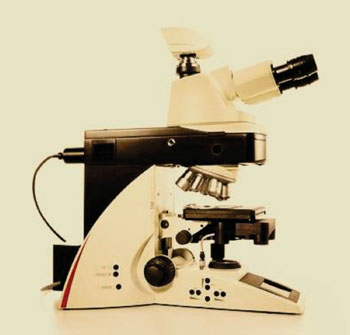Bacterial Infection Identified as Cause of Overactive Bladder Syndrome
By LabMedica International staff writers
Posted on 28 Jul 2016
Overactive Bladder (OAB) is currently characterized by symptoms of urgency, with or without urgency incontinence, with increased frequency, and nocturia, and in some cases pain, in the absence of urinary tract infection (UTI) or other defined underlying pathology.Posted on 28 Jul 2016
The exclusion of infection is determined by failure to isolate more than 105 colony forming units (CFU)/mL of a single species of bacteria from culture of a midstream urine (MSU) specimen and negative leukocyte esterase and/or nitrate urinalysis by dipstick.

Image: The DM4000 B automated LED microscope system (Photo courtesy of Leica Microsystems).
Scientists at the University of Kent (Chatham, UK) obtained bladder biopsies from local hospitals, and a catheter specimen of urine (CSU) was obtained from female patients and a MSU from male patients and non-OAB controls. All urine samples obtained were sent for conventional urinalysis and bacteria culture at the time of collection, if a UTI was subsequently identified the sample was retrospectively removed from the study.
The bladder biopsies were sectioned and stained and the morphological characteristics of the tissue evaluated. A DM4000B upright light microscope (Leica, Wetlar, Germany) was used to image the sections. A Luciferin Luciferase Adenosine triphosphate (ATP) Bioluminiscence Assay Kit was used to quantify ATP release from intact, live, bladder urothelium. ATP-evoked luminescence was quantified using a Synergy 2 luminometer (BioTek, Winooski, USA). The scientists also performed biopsy vesicle staining, biopsy ribonucleic acid (RNA) extraction and polymerase chain reactions, urine sediment immunofluorescence and urine nucleotide and nucleoside quantification.
The team found that some OAB patients had a low-grade inflammation, which is missed by conventional tests. This low-grade inflammation may ultimately result in increased sensory nerve excitation and the symptoms of OAB. They also found that in these patients the low-grade inflammation is associated with bacteria living inside the bladder wall. This was an observational study which means that no conclusions can be drawn about cause and effect. However, the findings may prompt the clinical re-classification of OAB and inform future therapeutic strategies. These might include protracted treatment with antibiotics to alleviate the symptoms of OAB in some individuals. The study was published on June 29, 2016, in the American Journal of Physiology.
Related Links:
University of Kent
Leica
BioTek














